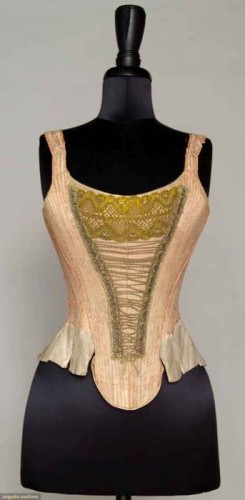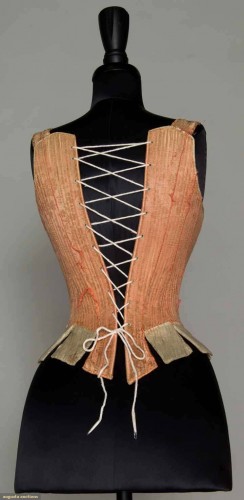I found these images of a fascinating pair of stays ex. Brooklyn Museum that were sold through Augusta Auctions.
The catalogue describes them as:
Bavarian Silk Stays, 1840-1860.
Pink satin, white leather waist tabs, attached metallic lace stomacher, multiple layers stiffened w/ baleen stays, homespun linen lining, B 30″, CFL 13″, (satin & metallic lace worn, linen lining replaced, leather dirty) fair. Brooklyn Museum
Now, I know that the regional peasant attire in many places stayed decades behind the current trends, but these look very 18th century to me. There is some obvious mistakes in the dressing: they are clearly meant to be spiral laced, and have been cross-laced instead, which just isn’t working, indicating that at least some of the people involved with documenting the stays didn’t know what they were doing. Does that include the person who dated them and wrote the description?
So what do you think, oh gurus of 18th century and European peasant wear? Are these a localised throwback to earlier styles and construction techniques, or mislabeled?



I vote that this is mislabeled. The tabs, the straps, the spiral lacing holes all scream that this is 18th century or a very good reproduction, and if that it the case, the catalogue should mention it.
Or, maybe someone shares the sentiment of the blog, and (not so) secretly enjoyed wearing the looks of previous eras. It’s a beautiful piece–why not?
Were there any notes about why they thought they were Victorian? I mean stuff like fabric or lace that dated later than the 18th c., or machine stitching? They’re curious.
The link I gave is the only info I have.
Wow. Possibly 18th century converted later to folk costume or fancy dress?
Possibly. I don’t even see anything about them to indicate a conversion – even the metal lace is 18th century accurate.
I know nothing about Bavarian folk costumes, and very little about the 18th century…but I do know that spiral lacing was still quite common in the 1840s and 50s. Even so, I vote mislabeled too. Many major costume collections have items that are grossly mis-dated, as you’ve been wise enough to point out before on this blog.
Hello again, by the way. It’s been a long time since I commented, but I read and enjoy your work nearly every day!
I’ve actually seen at least two 1880’s dresses that spiral laced, one somewhere online and one with my own eyes in the UmÄ›leckoprůmyslove muzeum in Prague.
But that’s about the only thing I can supply to the debate, I’m afraid.
I think they are early 19thc emulations of 18thc, there is just enough things to my eye that screams anachronism, mostly in the lines and proportions and the contour shape of the breast area but something else twinges my instincts also, just can’t put my finger on it.
I’m pretty sure the contour of the breast area is happening because of the mannequin it’s on. If you look at how wide the back lacings are at top you can clearly see that it would be much more of a cone shape on a better mannequin.
I do agree that there is something else that is just a tiny bit ‘off’ about it. That’s why I wasn’t quite ready to put it in the ‘museum mis-labelling’ file myself!
The close up images on the link, something about the neckline and how the straps attach to the front feel off. The side view where you can see into the arm scythe tells you it’s size for a larger maybe sitting higher bust than the from but there is still something odd about the geometry and is that chain top stitching unraveling and lifting away in the side view like a bad serge job?
I’m not an expert on the 18th century, but the shoulder straps and tabs at the bottom just seem plain *wrong* for the 19th century. Also, by the mid-19th century corsets were fastened up the front by hooks and eyes (which made it possible for the wearer to get in and out of her corset single-handedly without having to lace and unlace herself each time.)
However, something in the seaming and the curvature of the waist doesn’t seem right for the 18th century either …
I don’t think the front-opening thing applies here: that’s the case with corsets worn as underwear, but if this is really part of a folk costume, thus worn outside and very often old-fashioned, completely different things apply.
And the same thing goes with the tabs and straps… I am no expert on folk costumes and know nothing about German ones, but I saw some Czech folk costume stays online that were from the 19th century and had them, and it was indicated that the tabs are worn under the skirt even when the stays are worn outside. And those stays were differently shaped, more like short transitional stays, so there was much less chance of mislabelling.
– Ah, yes, this was one of those sites: http://tinyurl.com/d5fqpcw
The one which explains how it is worn. It’s stupid Google translation – sorry for that; I hope it makes sense.
So, my point being: It’s not Bavarian costume and looks different, but folk costumes in general do not conform to what we know of the history of fashions, so that sort of argumentation won’t help there.
Sorry for the rant.
I wish I could see them flat or on a better mannequin–because they seem a little curved for 18th century, but the rest of the style is certainly 18th century. I’m with Adela–there’s something off about the line. But–that could mean that they’re slightly less-than-usual 18th century stays (I don’t know much about German costume, it could be that this was “normal” for Bavaria), or an “updated” 1850s piece with the 18th century aesthetic intact. The auction notes state that the lining was replaced–perhaps these were an older piece that was used in multiple incarnations (“normal” stays eventually becoming a special occasion folk costume?) over mutliple generations (requiring some repair work), last used in the 1850s and that’s where the date came from? (OK, I like making up stories about clothes…)
I vote “mislabelled”, but there is definitely something about the curve at the waist that suggests 19th century. I suspect that’s to do with the mannequin though.
I vote for mostly mis-labelled, but perhaps not entirely so. The leather tabs may or may not be original, and it’s hard to tell without direct handling whether all the stitching (ie on the front timming) is original. Also, it was common for 18th century garments to be re-purposed in the mid-19th century when the silhouettes were more similar to each other than during the Regency/Romantic period(s). I wouldn’t be at all surprised if it’s latest use (whether for fancy dress or as folk costume) was in the mid-19th century.
Although 18th century Germany isn’t my strong suit at all, I’m guessing 3rd quarter 18th century originally, re-purposed and worn in the mid-19th century (there may well be some provenance info linking it to the later period).
It would be helpful to see the inside. Oh well.
well i’m not bavarian but grew up in germany and from what i know bavarian folk costume is actually very strongly influenced by 18th century styles, even today dirndl’s still have some elements like decorative front lacing bodices and such. that being said i’m not sure how slow change would have been in rual parts of germany fashion wise for an 19th century corset to be constructed like an 18th century one… i kind of think it was mislabeled but it could be possible to be part of a folk costume…